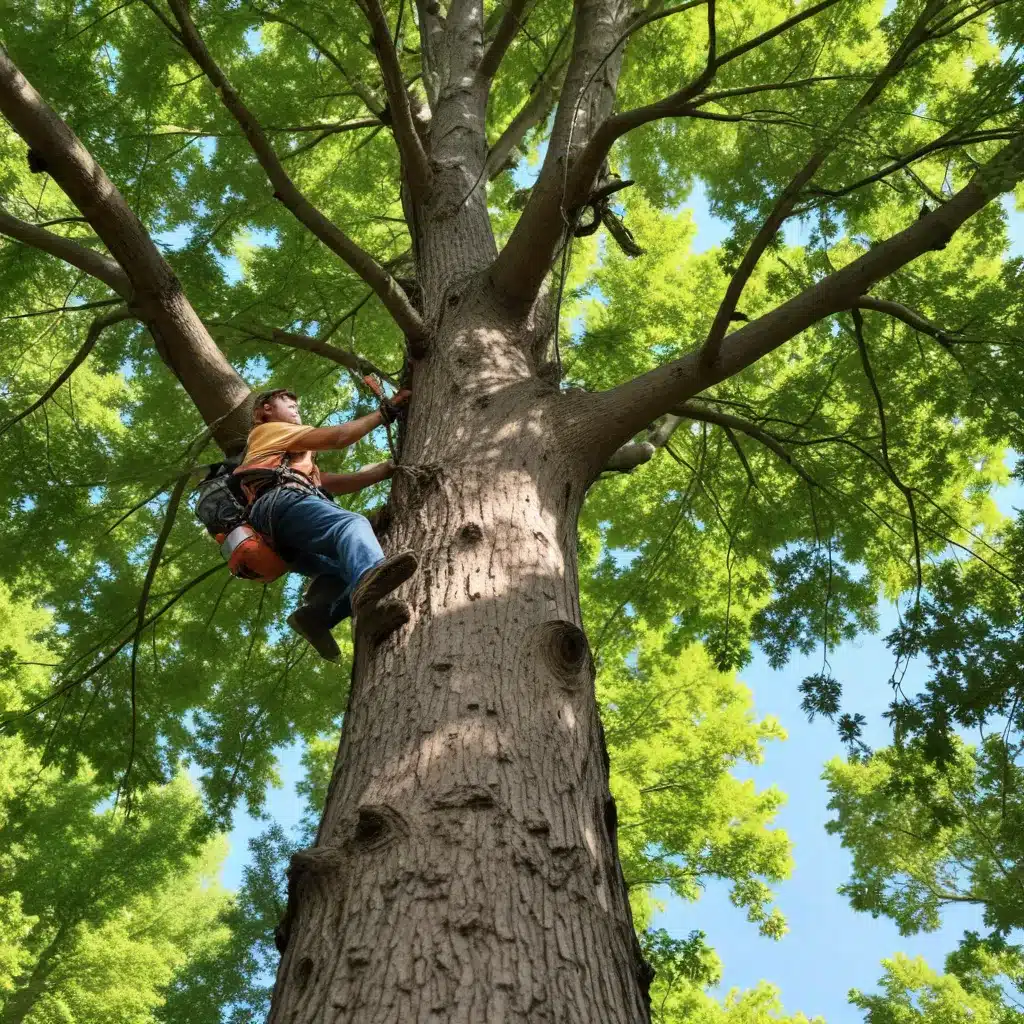
Invasive tree species can pose a serious threat to the ecological balance of natural areas, displacing native vegetation and disrupting essential ecosystem processes. As a TriCounty Tree Care specialist, I’m here to provide in-depth insights on how to effectively manage these problematic plants through a range of evidence-based removal strategies.
Identification of Invasive Species
The first step in addressing invasive tree species is proper identification. Some of the most common invasive trees found in our region include the Tree-of-Heaven (Ailanthus altissima), Callery Pear (Pyrus calleryana), and Russian Olive (Elaeagnus angustifolia). These species can be distinguished from native trees by their distinct leaf shapes, bark patterns, and growth habits.
For example, the Tree-of-Heaven features large, compound leaves with distinctive glandular teeth at the leaf base, while the Callery Pear has a pyramidal form and glossy, oval leaves that turn vibrant red in the fall. Careful observation of these key features is crucial for accurate identification, as misidentifying an invasive species could lead to inadvertent preservation or further spread.
Ecological Impacts of Invasive Trees
Invasive tree species pose a significant threat to local ecosystems by outcompeting and displacing native vegetation. These aggressive plants can rapidly colonize an area, forming dense monocultures that block sunlight and deprive the soil of essential nutrients. This, in turn, can lead to a decline in native plant diversity and the disruption of critical ecosystem functions, such as wildlife habitat, nutrient cycling, and soil stabilization.
The ecological impacts of invasive trees can be far-reaching. For instance, the Russian Olive can alter soil chemistry by fixing atmospheric nitrogen, making it difficult for native species to thrive. Similarly, the Callery Pear produces copious amounts of fruit that are readily consumed by birds, facilitating the dispersal of its seeds to new locations and accelerating its spread.
Removal Strategies
Addressing the challenge of invasive tree species requires a multifaceted approach, combining both mechanical and chemical control techniques. The TriCounty Tree Care team has extensive experience in implementing these strategies to effectively manage and eliminate these problematic plants.
Mechanical Removal Methods
Manual Uprooting: For small, isolated infestations, manually removing the entire plant, including the root system, can be an effective approach. This method is best suited for younger, smaller trees, as the task becomes increasingly difficult as the tree matures.
Cutting and Stump Removal: For larger, well-established invasive trees, cutting the trunk and removing the stump is often necessary. This approach can be labor-intensive, but it can be an effective way to prevent regrowth from the stump.
Chemical Control Techniques
Herbicide Application: In some cases, the use of targeted herbicides may be necessary to achieve long-term control of invasive tree species. Trained professionals at TriCounty Tree Care can apply these chemicals selectively, minimizing the impact on surrounding native vegetation.
Stump Treatment: Following the mechanical removal of a tree, the stump can be treated with herbicides to prevent resprouting. This method is particularly useful for species known to vigorously resprout, such as the Tree-of-Heaven.
Integrated Pest Management
For the most effective and sustainable management of invasive tree species, TriCounty Tree Care recommends an Integrated Pest Management (IPM) approach. This strategy involves combining mechanical and chemical control methods, as well as ongoing monitoring and maintenance to ensure the long-term suppression of these problematic plants.
By carefully assessing the specific conditions and challenges of each site, our team can develop a customized treatment plan that maximizes the chances of successful invasive tree removal while minimizing the impact on the surrounding environment.
Restoration and Revegetation
Once the invasive trees have been removed, the next step is to restore the natural ecosystem through revegetation with native species. This process involves carefully selecting plant species that are well-suited to the local climate and soil conditions, and then establishing them through planting or encouraging natural regeneration.
Native Species Selection: When choosing native trees and shrubs for revegetation, it’s important to consider factors such as growth habit, shade tolerance, and wildlife value. This ensures that the new plantings will thrive and contribute to the overall biodiversity of the site.
Reforestation Techniques: Depending on the scale of the project, TriCounty Tree Care can assist with planting new trees or facilitating natural regeneration through soil preparation, mulching, and the control of competing vegetation.
Regulations and Policies
Addressing invasive tree species often involves navigating a complex web of local and regional regulations and policies. TriCounty Tree Care stays up-to-date on the latest legislation and reporting requirements to ensure our clients remain in compliance.
Local and Regional Legislation: Many jurisdictions maintain lists of prohibited or regulated invasive species, and may have specific requirements for their removal and disposal. Our team is well-versed in these regulations and can guide you through the necessary steps.
Permitting and Reporting: Depending on the location and scale of the project, obtaining the appropriate permits and documenting the treatment activities may be required. TriCounty Tree Care can handle these administrative tasks, streamlining the process for our clients.
By staying informed and adhering to the relevant regulations, we can help you navigate the complexities of invasive tree species management while ensuring the protection of the local ecosystem.
At TriCounty Tree Care, we understand the significant threat that invasive tree species pose to our natural landscapes. Through a comprehensive approach that combines scientific expertise, practical experience, and a deep commitment to environmental stewardship, we are dedicated to helping our clients effectively manage and eradicate these problematic plants. Contact us today to learn more about our invasive tree species removal services and how we can assist you in restoring the ecological balance of your property.


